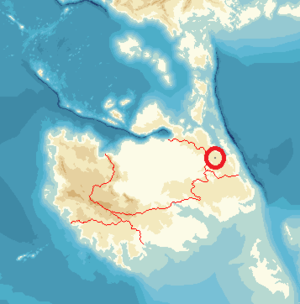Difference between revisions of "Kwalia language"
Anonymous123 (talk | contribs) m (→Phonotactics) |
Anonymous123 (talk | contribs) m |
||
| Line 3: | Line 3: | ||
|name = Tayam | |name = Tayam | ||
|altname = Teyam, Taiyam, Enaawata | |altname = Teyam, Taiyam, Enaawata | ||
|nativename = '' | |nativename = ''táhɨyám'' | ||
|pronunciation = [ | |pronunciation = [táhɨ̀jám] | ||
|states = | |states = | ||
|region = southern [[Awating]] | |region = southern [[Awating]] | ||
| Line 32: | Line 32: | ||
}} | }} | ||
'''Tayam''' (autonym: '' | '''Tayam''' (autonym: ''táhɨyám''), previously known as ''Taiyam'', ''Teyam'', or ''Enaawata'', is a language isolate spoken in southeastern [[Awating]]. | ||
==Discovery== | ==Discovery== | ||
Revision as of 06:26, 2 February 2021
| Tayam | |
|---|---|
| Teyam, Taiyam, Enaawata táhɨyám | |
| Pronunciation | [táhɨ̀jám] |
| Region | southern Awating |
| Ethnicity | Tayam |
| Native speakers | unknown: - possibly extinct (2009) - about 590 speakers claimed (2020) |
| Language family | Language isolate (previously classified as Ngerupic) |
| CWS code | ytm |
 | |
Tayam (autonym: táhɨyám), previously known as Taiyam, Teyam, or Enaawata, is a language isolate spoken in southeastern Awating.
Discovery
Classification and number of speakers
Tayam has been proven to be a language isolate, unrelated to any other languages. There have been numerous controversies about its classification, stemming from prior lack of reliable information about the language.
Debate on Tayam as a Ngerupic language
From when study of the language began in the early 1960s to about 2014, very little reliable data was available about the language, due to the relative inaccessibility and isolation of the Tayam-speaking area and small number of speakers. While the sparse data did suggest that it may have been an isolate, linguists at the time generally classified Tayam as a Ngerupic language, owing to shared areal features in common with the Ngerupic languages of Awating.
Debate on Tayam as an Aga-Buod language
A few linguists, primarily Amang Řąziya Ngunrą Zahang, have posited that Tayam is related to the Ngigu language of southern coastal Awating, and therefore related to the Aga-Buod languages of Lahan via a Trans-Umo-Aga-Buod language macrofamily. This has not been accepted by mainstream academia and is regarded as a fringe theory.
Debate on Tayam as a constructed or artificial language
Some scholars have claimed that Tayam was invented by groups of rural bandits as a method of concealing information, citing its areally unusual phonology and grammar.
Phonology
Phonemes
Tayam has a total of 20 phonemes across both consonants and vowels, which is towards the lower end of the spectrum when compared with other languages worldwide.
Consonants
Tayam has 14 consonant phonemes, a relatively small consonant inventory, especially when compared to other languages of Awating. It is remarkable for its miniscule fricative inventory, containing only the glottal fricative /h/; also unusual is the presence of /ɺ/, a rare phoneme among the nearby Ngerupic languages as well as worldwide.
| Bilabial | Alveolar | Palatal | Labiovelar | Velar | Glottal | |
|---|---|---|---|---|---|---|
| Nasal | m | n | ŋ | |||
| Plosive | p ᵐb | t ⁿd | k ᵑg | ʔ | ||
| Fricative | h | |||||
| Lateral flap | ɺ | |||||
| Approximant | j | w |
Notes:
- The prenasalized stops /ᵐb ⁿd ᵑg/ are realized as [b d g] after another consonant.
- The voiceless stops /p t k/ are frequently realized as [β ɾ ɣ] intervocalically.
- The lateral flap /ɺ/ becomes [ɾ] word-finally.
Vowels
Tayam has 6 phonemic vowels, each of which can occur with one of two level tones: high and low. Tone sandhi also occurs at the boundary between vowels, as explained below.
| Front | Central | Back | |
|---|---|---|---|
| Close | í ì | ɨ́ ɨ̀ | ú ù |
| Mid | é̞ è̞ | ó̞ ò̞ | |
| Open | á à |
Notes:
- The central vowel /ɨ/ is in free variation with [ə].
- Vowel sequences are treated as diphthongs, with sandhi applying as contour tone; a low tone before a high tone creates phonetic rising tone, and a high tone before a low tone triggers phonetic falling tone.
Phonotactics
Tayam’s syllable structure is (C1)(L)V(V)(C2), where C1 is any consonant, L is a liquid, V is any vowel, and C2 is any non-glottal consonant. The epenthetic vowel /ɨ̀/ is inserted between geminated consonsants and between the consonants in word-final clusters, e.g. /m-m/ > /mɨ̀m/. Consonant clusters without liquids are allowed word-initially/syllable-initially if there is a preceding coda vowel.